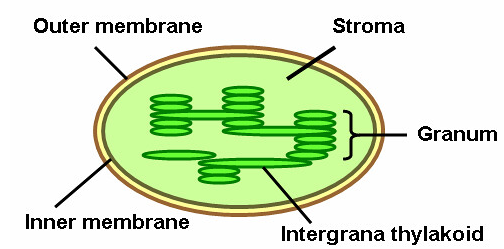Answer
433.5k+ views
Hint: The dark reaction is also known as carbon assimilation reaction. In this reaction the inorganic form of carbon is converted to organic form in organelle known as chloroplasts.
Complete step by step answer:
Photosynthesis takes place in two major steps.
-Light reaction and the dark reaction.
ATP and NADPH is formed during the light reaction. Which is utilised for the fixation of carbon in the dark reaction. Carbon fixing during the dark reaction which is the light independent process takes place in the stroma of the chloroplast.
The light reactions of photosynthesis occur in the thylakoid grana present in the chloroplast.
-Dark reaction is also known as Calvin cycle or light independent reactions.
Dark reactions of photosynthesis are the chemical reactions that convert carbon dioxide and other compounds into glucose. These reactions occur in the stroma. Stroma is a fluid filled area of a chloroplast outside the thylakoid membrane. These reactions take the products ATP and NADPH of light dependent reaction and perform further chemical processes on them.
The Calvin cycle uses the reducing power of ATP and NADPH of the light reaction to produce sugar for the plants to use. There is no direct reaction to convert carbon into sugar but there are series of reactions that are called Calvin Cycle.
Structure of chloroplasts-

Hence option A is correct.
Note:
There are three steps in the Calvin cycle: carbon fixation, reduction reaction, ribulose 1,5-bisphosphate regeneration.
Six turns of the Calvin cycle are required for the production of one molecule of glucose.
Complete step by step answer:
Photosynthesis takes place in two major steps.
-Light reaction and the dark reaction.
ATP and NADPH is formed during the light reaction. Which is utilised for the fixation of carbon in the dark reaction. Carbon fixing during the dark reaction which is the light independent process takes place in the stroma of the chloroplast.
The light reactions of photosynthesis occur in the thylakoid grana present in the chloroplast.
-Dark reaction is also known as Calvin cycle or light independent reactions.
Dark reactions of photosynthesis are the chemical reactions that convert carbon dioxide and other compounds into glucose. These reactions occur in the stroma. Stroma is a fluid filled area of a chloroplast outside the thylakoid membrane. These reactions take the products ATP and NADPH of light dependent reaction and perform further chemical processes on them.
The Calvin cycle uses the reducing power of ATP and NADPH of the light reaction to produce sugar for the plants to use. There is no direct reaction to convert carbon into sugar but there are series of reactions that are called Calvin Cycle.
Structure of chloroplasts-

Hence option A is correct.
Note:
There are three steps in the Calvin cycle: carbon fixation, reduction reaction, ribulose 1,5-bisphosphate regeneration.
Six turns of the Calvin cycle are required for the production of one molecule of glucose.
Recently Updated Pages
Mark and label the given geoinformation on the outline class 11 social science CBSE

When people say No pun intended what does that mea class 8 english CBSE

Name the states which share their boundary with Indias class 9 social science CBSE

Give an account of the Northern Plains of India class 9 social science CBSE

Change the following sentences into negative and interrogative class 10 english CBSE

Advantages and disadvantages of science

Trending doubts
Difference between Prokaryotic cell and Eukaryotic class 11 biology CBSE

Differentiate between homogeneous and heterogeneous class 12 chemistry CBSE

Fill the blanks with the suitable prepositions 1 The class 9 english CBSE

Which are the Top 10 Largest Countries of the World?

Give 10 examples for herbs , shrubs , climbers , creepers

10 examples of evaporation in daily life with explanations

Difference Between Plant Cell and Animal Cell

Write a letter to the principal requesting him to grant class 10 english CBSE

Change the following sentences into negative and interrogative class 10 english CBSE



